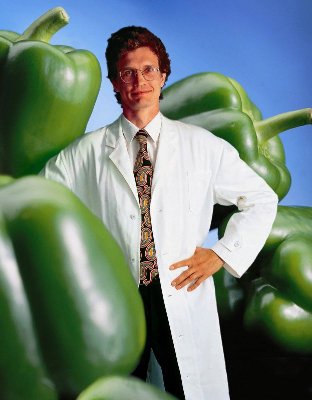

Harri Hemilä
Department of Public Health,University of Helsinki,
Helsinki, Finland
Harri Hemilä
harri.hemila@helsinki.fi
http://www.mv.helsinki.fi/home/hemila
PUBMED
OA.mg
Scopus
University of Helsinki list
Tiede ja Tutkimus
Google Scholar
Researchgate
KUDOS
Mendeley
Web of Science
Vitamin C was first produced in large amounts from Paprika
Vitamin C was identified in the 1930s by Albert Szent-Gyorgyi, who received his Nobel Prize partly for this work. He found that paprika is a particularly rich source of the vitamin, which made it possible to produce kilograms of it for research purposes ([1963] Annu Rev Biochem 32: 1-14). Nowadays, the most convenient way to increase vitamin C intake is by way of 500-mg tablets, but further research is needed to explore the conditions in which supplementation may be beneficial.
Papers by and about:
Albert Szent-Gyorgyi
Charles King did important research on vitamin C before Szent-Gyorgyi identified it.
Papers by and about:
Charles Glenn King
In 1971, Linus Pauling published a meta-analysis of 4 placebo-controlled trials in which at least 0.1 g/day of vitamin C was administered regularly to the study group. Pauling concluded that there was strong evidence that vitamin C decreased "integrated morbidity" due to colds (P = 0.000022).
Papers by and about Linus Pauling
Summary of Paulings work on vitamin C and colds
Frederick Klenner and Robert Cathcart wrote a series of interesting case reports of using vitamin C in high doses and Irwin Stone summarized the early literature on vitamin C in his book
Tests available via the net: Klenner, Cathcart, Stone
Suomenkielisiä C-vitamiinia käsitteleviä kirjoituksia eri kirjoittajien kirjoittamana
Finnish papers on vitamin C
Collection of links to papers describing the Chandra case

Vitamin C was identified in the 1930s by Albert Szent-Gyorgyi, who received his Nobel Prize partly for this work. He found that paprika is a particularly rich source of the vitamin, which made it possible to produce kilograms of it for research purposes ([1963] Annu Rev Biochem 32: 1-14). Nowadays, the most convenient way to increase vitamin C intake is by way of 500-mg tablets, but further research is needed to explore the conditions in which supplementation may be beneficial.
Papers by and about:
Albert Szent-Gyorgyi
Charles King did important research on vitamin C before Szent-Gyorgyi identified it.
Papers by and about:
Charles Glenn King
In 1971, Linus Pauling published a meta-analysis of 4 placebo-controlled trials in which at least 0.1 g/day of vitamin C was administered regularly to the study group. Pauling concluded that there was strong evidence that vitamin C decreased "integrated morbidity" due to colds (P = 0.000022).
Papers by and about Linus Pauling
Summary of Paulings work on vitamin C and colds
Frederick Klenner and Robert Cathcart wrote a series of interesting case reports of using vitamin C in high doses and Irwin Stone summarized the early literature on vitamin C in his book
Tests available via the net: Klenner, Cathcart, Stone
Suomenkielisiä C-vitamiinia käsitteleviä kirjoituksia eri kirjoittajien kirjoittamana
Finnish papers on vitamin C
Collection of links to papers describing the Chandra case
 https://orcid.org/0000-0002-4710-307X
https://orcid.org/0000-0002-4710-307X